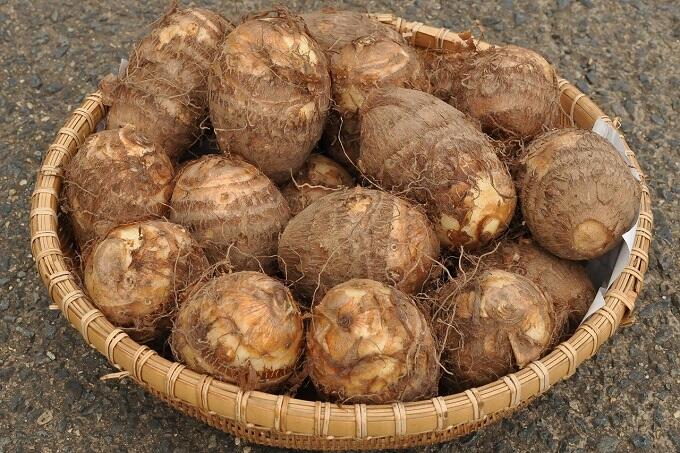Futago Satoimo / Futago Imonoko
| Registration Number | 68 |
|---|---|
| Name of the GI | Futago Satoimo, Futago Imonoko |
| Class | Vegetables/ Cereal grains/Pulses |
| Date of Protection | 2018/09/27 |
| Producing Area |
Iwate Prefecture
Kitakami City |
| Applicant - Name and Address | Futago Satoimo Association 1-1 Yoshi-cho, Kitakami City, Iwate Prefecture |
Producing Area
Futago Satoimo is a native strain of satoimo (Japanese taro) characterized by a sticky texture, rich flavor and smoothness.
This fluffy and delicious taro is a popular product around the production area, partly because it keeps its shape without breaking into pieces even when boiled or simmered.
While Futago Satoimo produces large koimo (child satoimo, cormels) that are uniform in size and quality, difficulty in storing seed tubers leads more than 20% of the harvest to be saved as seed tubers. This limits the amount of Futago Satoimo that can be shipped, and gives scarcity value to the product, resulting in a trading price almost twice as high as that of satoimo grown in other areas.
For the production of Futago Satoimo, the strain Futago Satoimo native to the area is grown in Kitakami City. Harvested products are shipped after excluding satoimo with any rot, deterioration, deformation, and damage, disease, pests, freeze and cold, although products with minimal damage may be shipped as substandard products after removing the affected parts of the corms.
The producing area of Futago Satoimo is a floodplain of the Kitakami River (1), with well-drained, fertile soil that is deeply cultivated, suitable for growing satoimo, a deeply rooted crop.
Since early times, producers of Futago Satoimo have handed down their techniques for storing seed tubers, which constitutes a challenging part of the production, and have established a practice of accommodating those who were unable to successfully preserve their seed tubers with substitute seed tubers provided by their fellow producers.
The entire community contributes to continued protection and passing down of the cultivation techniques and seed tubers, inherited from their ancestors, to the next generation.
A historical record of the area, Futago Monogatari (A History of Futago Village), reveals that during the late Meiji era (2), satoimo (Futago Satoimo) came second to rice in terms of production, suggesting that the produce has been valued as a cash crop since those times.
In 1980, the Futago Satoimo Producers' Association was formed to establish unified standards for grading and shipping and to improve the cultivation techniques. This has since contributed to ensuring stable production of high-quality satoimo and establishing Kitakami City as the largest satoimo producer in the Tohoku region which is the northeast part of Honshu, the largest island of Japan.
As of 2016, Futago Satoimo is produced by about 98 farmers with a total area of 34 ha in Kitakami City, mainly in the Futago region, with annual shipments amounting to 197 tons.
- Kitakami River: The fourth longest river in Japan and the longest in the Tohoku region (249 km long) that flows from northern Iwate Prefecture to southeastern Miyagi Prefecture. The river often appears in literature, including the works of Miyazawa Kenji (1896-1933), a poet and novelist of children's literature, and Ishikawa Takuboku (1886-1912), a poet, who are both from the Tohoku region.
- Meiji era: An era of Japanese history extending from 1868 to 1912, during which Japan shifted from feudalism under the Shogunate to a modernized nation state.


